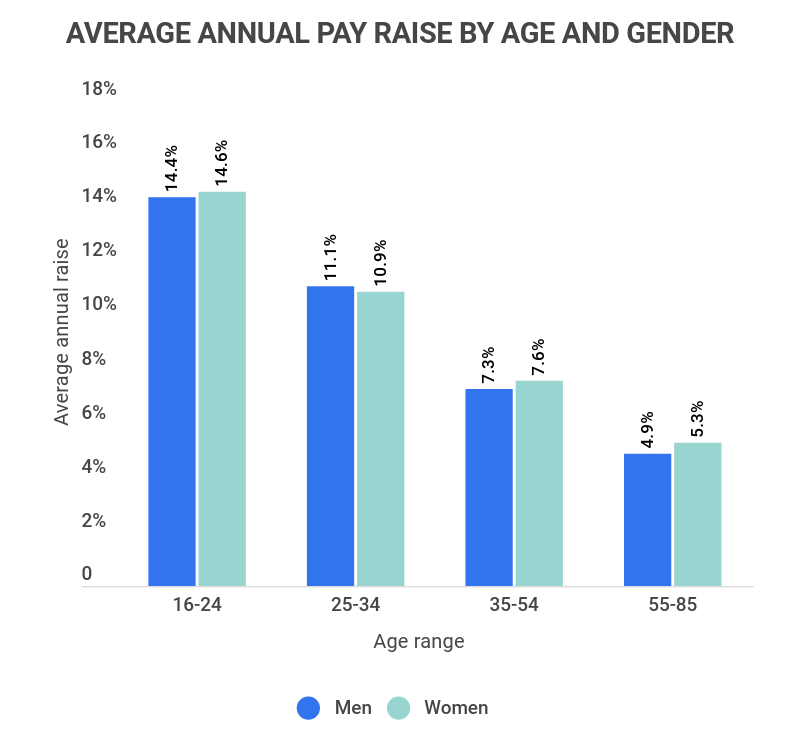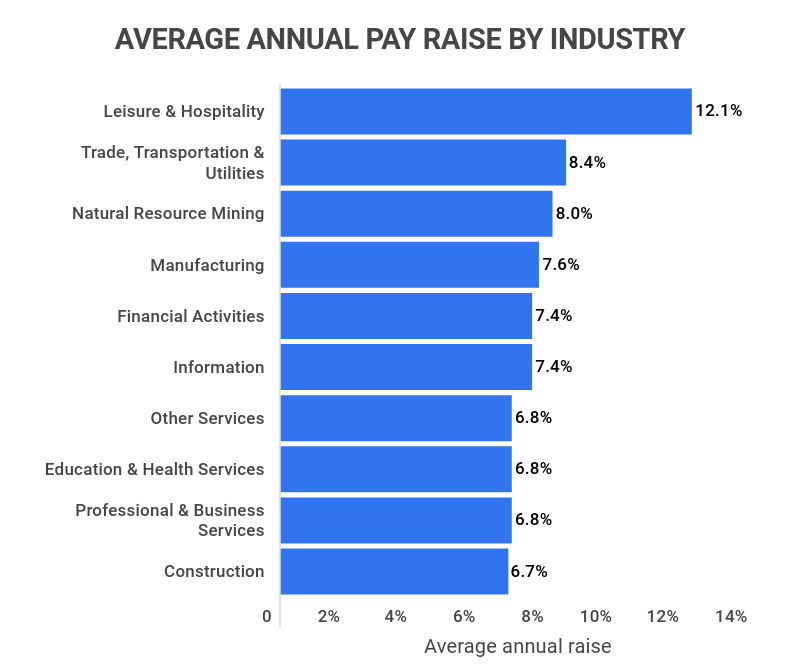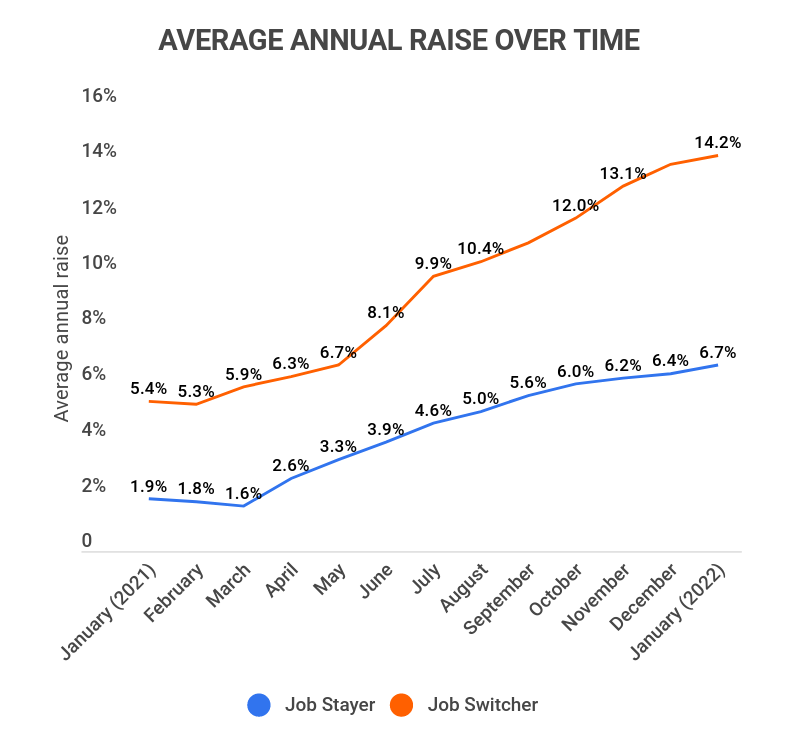- Income Statistics
- Average PTO Days
- What Percentage of Americans Live Paycheck to Paycheck?
- Average American Income
- Millionaire Statistics
- Average Salary out of College
- Average Bonus Statistics
- Minimum Wage Statistics
- Union Benefits Statistics
- Savings Statistics
- Average Annual Raise
- Income Inequality Statistics
- How Many People Make Over 100k?
- Average 401(k) Sstatistics
- Average Net Worth Statistics
- $100k After-Tax Income By State
- Average Global Income
Research Summary: Everyone likes getting a raise. Even if you’re not changing jobs or gunning for that next promotion, understanding what to expect out of an annual raise is important.
After all, anything from where you live to what industry you work in can have a significant effect on your average raise.
Luckily, we’ve investigated all of the essential facts about average annual raises across the US. According to our extensive research:
-
The average annual raise in the US is 7.6% as of 2022.
-
The average salary increase when changing jobs is 14.8%, while wage growth is 5.8% for those who remain at their job.
-
Wyoming workers experienced the highest annual salary increase from 2021-2022, at 11.2%.
-
When asking for a raise, 82% of men will receive it compared to 74% of women.
-
The Leisure and Hospitality industry had the highest annual raise within the past year, at 12.1%.
For further analysis, we broke down the data in the following ways:
Regional Average | Demographics | Industry | Changes in Average
Regional Average Pay Raise Rates
The US is a vast country, and with that comes regional diversity. As of 2022, the average pay raise can vary a lot from state to state. According to our research:
-
Wyoming has experienced the highest annual salary increase from 2021-2022, at 11.2%.
Yellowstone and Bison jerky isn’t the only perk of living in Wyoming, as workers in the state have seen a significant salary increase within the past year. Other states that have had high salary increases include: Arkansas (10.9%), Florida (10.8%), Maine (10.3%), and Indiana (9.8%).
-
California has experienced the lowest annual salary increase from 2021-2022, at 1%.
While this is, in part, due to California’s already high minimum wage, it’s still a bummer for workers. Other states that have had slow raises include: Maryland (2%), Washington (3.8%), Hawaii (4.2%), and New Jersey (4.6%).
Percent Salary Increase By State
| State | Annual Salary Increase (2021-2022) |
|---|---|
| Alabama | 8.2% |
| Alaska | 4.9% |
| Arizona | 7.5% |
| Arkansas | 10.9% |
| California | 1.0% |
| Colorado | 8.8% |
| Connecticut | 9.2% |
| Delaware | 7.5% |
| Florida | 10.8% |
| Georgia | 8.8% |
| Hawaii | 4.2% |
| Idaho | 8.5% |
| Illinois | 7.3% |
| Indiana | 9.8% |
| Iowa | 7.6% |
| Kansas | 9.0% |
| Kentucky | 7.6% |
| Louisiana | 8.6% |
| Maine | 10.3% |
| Maryland | 2.0% |
| Massachusetts | 5.9% |
| Michigan | 6.2% |
| Minnesota | 6.8% |
| Mississippi | 8.5% |
| Missouri | 7.0% |
| Montana | 8.3% |
| Nebraska | 9.2% |
| Nevada | 8.0% |
| New Hampshire | 7.8% |
| New Jersey | 4.6% |
| New Mexico | 6.5% |
| New York | 5.6% |
| North Carolina | 9.2% |
| North Dakota | 6.9% |
| Ohio | 7.5% |
| Oklahoma | 8.0% |
| Oregon | 7.4% |
| Pennsylvania | 6.9% |
| Rhode Island | 6.8% |
| South Carolina | 9.2% |
| South Dakota | 8.6% |
| Tennessee | 8.8% |
| Texas | 8.7% |
| Utah | 8.2% |
| Vermont | 7.7% |
| Virginia | 6.1% |
| Washington | 3.8% |
| West Virginia | 6.1% |
| Wisconsin | 8.7% |
| Wyoming | 11.2% |
Average Annual Raise by Demographics
Personal characteristics like age and gender can also have an impact on the average annual raise you might expect to see. To find out more, we’ve gathered some important facts:

Average Pay Raise Percent By Age And Gender
| Age range | Men | Women |
|---|---|---|
| 16-24 | 14.4% | 14.6% |
| 25-34 | 11.1% | 10.9% |
| 35-54 | 7.3% | 7.6% |
| 55-85 | 4.9% | 5.3% |
-
Those between 16-24 receive the highest pay raises, at 14.5% on average.
However, women earn slightly higher than men, at 14.6% compared to 14.4%. A trend that holds true for most age groups.
-
Those between 55-85 receive the lowest pay raises, at only 5.1% on average.
In this age range, women have higher pay raises at a greater disparity, receiving an average 5.3% increase compared to a 4.9% increase for their male counterparts.
-
The only age range where men receive higher pay raises than women is between 25-34.
In this age range, men receive an average 11.1% increase compared to 10.9% for women.
-
On average, women receive 14% higher wage growth when changing jobs.
When changing jobs for men, the average wage growth is 5.5%, and the average for women is 6.4%. Women have also seen a more steady increase in their wage growth when changing jobs, with a 1.1% uptick from 2020-2021.
On the other hand, men only saw a 0.2% increase. However, women still make less than men on average, at a rate of $32.61 to $27.79.
Average Annual Raise by Industry
The industry you work in can also have a huge impact on whether or not you’ll receive a high pay raise at the end of the year. For example, here are some insights our research uncovered:
-
The Leisure & Hospitality industry has seen the highest annual raise within the past year, at 12.1%.
The Leisure and Hospitality industry took a massive hit in 2020 but seems to be recovering. Other industries that have seen high annual raises include Trade, Transportation & Utilities (8.4%), and Natural Resource Mining (8%).
-
The Construction industry had the lowest annual raise within the past year, at only 6.7%.
That’s only a little over half that of the Leisure and Hospitality industry, and there are other industries with low annual raises within the past year as well. For example, Education & Health Services, as well as Professional & Business Services, both had annual raise increases of 6.8%.

Average Percent Raise By Industry
| Industry | Annual Raise (2021-2022) |
|---|---|
| Leisure & Hospitality | 12.1% |
| Trade, Transportation & Utilities | 8.4% |
| Natural Resource Mining | 8.0% |
| Manufacturing | 7.6% |
| Financial Activities | 7.4% |
| Information | 7.4% |
| Other Services | 6.8% |
| Education & Health Services | 6.8% |
| Professional & Business Services | 6.8% |
| Construction | 6.7% |
Changes in Average Annual Raises Over Time
Whether workers chose to change jobs or stay in the same field, their average annual raises differ month by month and year by year. Here are some prominent trends:
-
Year-over-year annual raises for January increased by over 300% between 2021-2022.
In January of 2021, the year-over-year annual raise for those who stayed in their jobs was only 1.6%. However, that number increased to 6.7% in January 2022.
-
Annual raises for job switchers were also high, increasing by 163% between 2021-2022.
In January of 2021, the average annual raise for job switchers was 5.4%, a number that increased to 14.2% in 2022.

Raises Of Job Stayers Vs. Job Switchers
| Month | Job Stayer | Job Switcher |
|---|---|---|
| January (2021) | 1.9% | 5.4% |
| February | 1.8% | 5.3% |
| March | 1.6% | 5.9% |
| April | 2.6% | 6.3% |
| May | 3.3% | 6.7% |
| June | 3.9% | 8.1% |
| July | 4.6% | 9.9% |
| August | 5% | 10.4% |
| September | 5.6% | 11.1% |
| October | 6% | 12% |
| November | 6.2% | 13.1% |
| December | 6.4% | 13.9% |
| January (2022) | 6.7% | 14.2% |
Average Annual Raise FAQ
-
How much should my salary increase each year?
Your salary should increase by at least 3-5% per year. While annual raises vary a lot depending on your circumstance, a raise of at least 5% is more than adequate. Anything above that would be considered higher than average.
Of course, the average annual increase between 2021-2022 is 7.6%, but this is partially due to abnormally high inflation rates.
-
Should I ask for a raise every year?
Yes, you should ask for a raise every year if you don’t receive one automatically. Generally speaking, most companies will naturally raise their pay over time; however, if you’ve been working for a company for over a year and haven’t seen your salary go up, it’s appropriate to ask for a raise.
Additionally, if you’re starting a new job, you’ll want to wait at least six months before you ask for a raise.
-
How long should you work without a raise?
You should work for at least one to two years without a raise. On average, waiting any longer than two years is too long, and working a job for three years without a raise is unacceptable.
If you feel as though you’ve been working your current job for too long without receiving a raise, you should contact your boss or HR and politely discuss the issue. If your wage stagnation persists, it might be time to look for other career opportunities.
-
Is a 5% yearly raise good?
Yes, a 5% yearly raise is good, however it is not exceptional. Many raises fall between the 3% and 5% mark. 5% raises are good if they stay above inflation and cost of living. Understand though that as a raise, it does little to reflect any reward for extreme effort or success.
Conclusion
The average annual raise you receive in the US can vary a lot depending on where you live, how old you are, or what industry you work in. A miner in Wyoming may have seen a significant raise this past year, maybe even over 10%, while a construction worker in California might feel like their wages were stagnant.
Either way, annual raises from 2021-2022 have been higher than in previous years but not necessarily high enough to catch up with rising inflation.
Regardless of your current situation, it’s important to understand that you have value as a worker. If you feel as though your wages are stagnant, it’s important to reach out to your boss or consider the option of changing jobs.
References
-
MarketPlace. “Men and women ask for pay raises at the same rate — but men get them more often.” Accessed on September 7th, 2022.
-
BLS. “Percent change in average weekly wages by state, total covered employment.” Accessed on September 8th, 2022.
-
ADP. “ADP® Pay Insights.” Accessed on September 8th, 2022.
-
SHRM. “2022 Salary Increases Look to Trail Inflation.” Accessed on September 8th, 2022.
- Income Statistics
- Average PTO Days
- What Percentage of Americans Live Paycheck to Paycheck?
- Average American Income
- Millionaire Statistics
- Average Salary out of College
- Average Bonus Statistics
- Minimum Wage Statistics
- Union Benefits Statistics
- Savings Statistics
- Average Annual Raise
- Income Inequality Statistics
- How Many People Make Over 100k?
- Average 401(k) Sstatistics
- Average Net Worth Statistics
- $100k After-Tax Income By State
- Average Global Income







